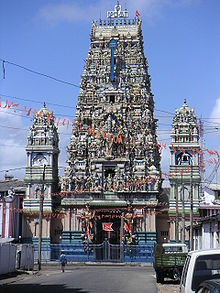Company Roads
History
The name "Slave Island" was coined during the period of British colonial rule and was a reference to the usage of the island under Portuguese rule as a holding area for African slaves, most of them from the Swahili coast and Portuguese East Africa. Many of these slaves later returned to Africa. However, a small group of African descendants remain scattered throughout Sri Lanka and are collectively known as Sri Lankan Kaffirs.
In 2023, the Sri Lankan Prime Minister issued instructions to discontinue the use of exonym "Slave Island" in favour of "Kompagngna Veediya” in all three official languages.
Demographic

Kompagngna Veediya is a multicultural area known today for its mix of Malay, Sinhalese and Tamil cultures and is a traditional Malay cultural district in Colombo. The larger ethnic communities in Company Roads are the Sri Lankan Malays, Sri Lankan Muslims and Sinhalese. There are also various minorities, such as Burghers and others. Religions include Islam, Buddhism, Hinduism, Christianity and various other religions and beliefs.
Since colonisation, the neighbourhood was viewed as a distinctly Malay neighbourhood but it has traditionally been multi-ethnic and was home to multiple Asian communities during colonial rule, including Bengalis, Afghans, Marwaris, Burmese and Chinese in addition to Malays.
Infrastructure
Kompagngna Veediya is served by the Company Roads Railway Station. Built with Victorian-era architectural embellishments, the station carries significant architectural and historic value. The building features stylish arches, intricate woodwork and metal installations, which emphasise Victorian-era styles.
Demolitions
Many historic buildings in the Kompagngna Veediya area were either demolished or are awaiting to be demolished due to recent high rise development. Despite the architectural and historic value most buildings are not properly maintained and as a result most have become run down. The shophouse-style buildings in Justice Akbar Mawatha which are to be demolished is said to be the place where D.R. Wijewardene, D.S. Senanayake and Oliver Goonetilleke met to discuss the constitutional reforms that led to Sri Lanka's independence in 1948.
Military
Diplomatic missions
- Consulate of Republic of Cyprus
- Consulate of Madagascar
- Consulate of Philippines
- High Commission of New Zealand
Photos
-
The Seema Malakaya of the Gangarama Temple in the Beira Lake in the Company Roads area, is one of many religious structures in Colombo
References
- ^ "Prime Minister's Office, Sri Lanka". www.news.lk. Retrieved 2024-05-21.
- ^ "The Slave Island That We Have Forgotten". roar.media. Retrieved 2021-09-14.
- ^ Careem, Tuan M. Zameer (2017). Persaudaraan: Malay life in Sri Lanka (2nd ed.). Colombo, Sri Lanka: S. Godage & Brothers (Pvt) Limited. p. 40. ISBN 9789553082022.
- ^ de Silva Jayasuriya, S. (1999). Portuguese in Sri Lanka: influence of substratum languages. Journal of the Royal Asiatic Society of Great Britain and Ireland 9(2): 251-270.
- ^ "The Slave Island That We Have Forgotten". roar.media. Retrieved 2021-09-14.
- ^ "Residents Express Mixed Emotions as Historic Slave Island Prepares for Demolition". Global Press Journal. 2013-08-29. Retrieved 2021-09-14.
- ^ "Slave Island".
- ^ "Protecting historic Slave Island Railway Station". Community/Livelihood Development. John Keells Group. Archived from the original on 2016-03-04. Retrieved 2012-01-06.
- ^ "Residents Express Mixed Emotions as Historic Slave Island Prepares for Demolition". Global Press Journal. 2013-08-29. Retrieved 2018-08-22.
- ^ "Roar Media". roar.media. Retrieved 2018-08-22.
- ^ "Don't bulldoze our colonial shop houses into oblivion". The Sunday Times Sri Lanka. Retrieved 2018-08-22.
